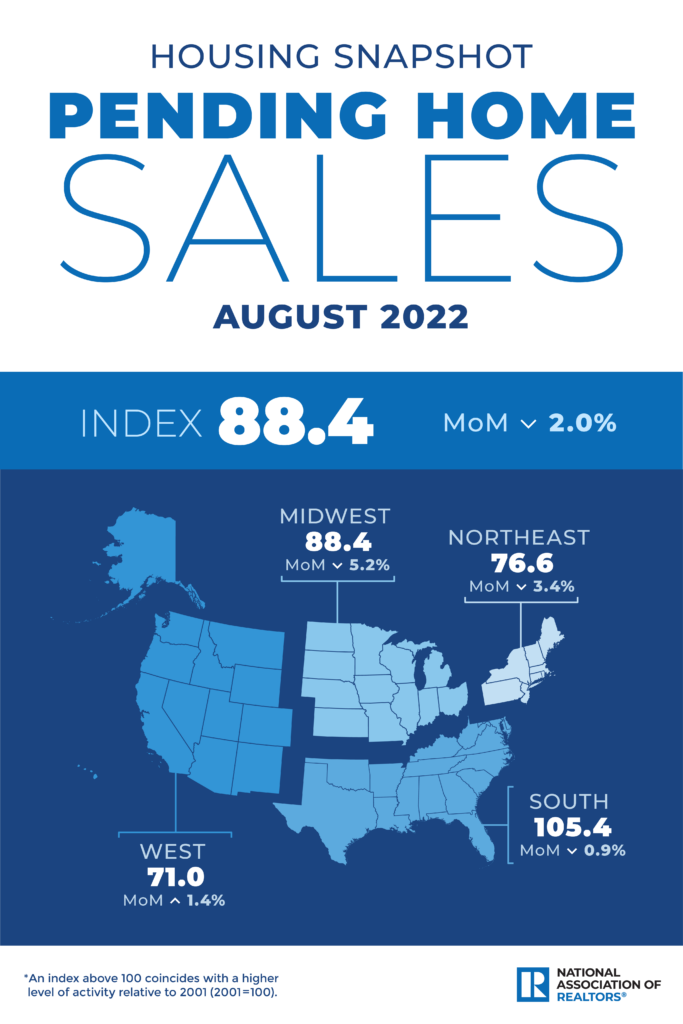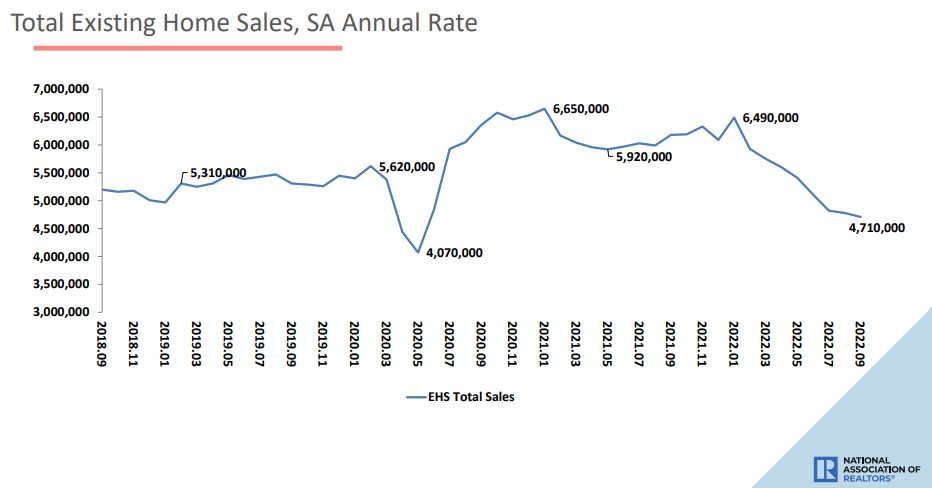 For the eighth consecutive month, existing-home sales fell in September 2022, this time retracting by 1.5% from August 2022 to a seasonally adjusted rate of 4.71 million units. On a yearly basis, sales fell by 23.8% when the market reported 6.18 million in sales.
For the eighth consecutive month, existing-home sales fell in September 2022, this time retracting by 1.5% from August 2022 to a seasonally adjusted rate of 4.71 million units. On a yearly basis, sales fell by 23.8% when the market reported 6.18 million in sales.
This information comes by way of the National Association of Realtor’s monthly Existing-Home Sales Report, which tracks completed transactions across the country which include single-family homes, townhomes, condominiums, and co-ops.
"The housing sector continues to undergo an adjustment due to the continuous rise in interest rates, which eclipsed 6% for 30-year fixed mortgages in September and are now approaching 7%," said Lawrence Yun, the NAR’s Chief Economist. "Expensive regions of the country are especially feeling the pinch and seeing larger declines in sales."
The total amount of housing inventory recorded at the end of September was 1.25 million units, down 2.3% from August and 0.8% over the same period last year. Unsold inventory sits at a 3.2-month supply at the current sales pace—unchanged from August and up from 2.4-months in September 2021.
"Despite weaker sales, multiple offers are still occurring with more than a quarter of homes selling above list price due to limited inventory," Yun added. "The current lack of supply underscores the vast contrast with the previous major market downturn from 2008 to 2010, when inventory levels were four times higher than they are today."
Looking at the median existing-home price (which includes every type of housing) rose 8.4% to $384,800 over the $355,100 reported in September 2021.
“This marks 127 consecutive months of year-over-year increases, the longest-running streak on record. It was the third month in a row, however, that the median sales price faded after reaching a record high of $413,800 in June, the usual seasonal trend of prices trailing off after peaking in the early summer,” said the NAR.
Properties typically remained on the market for 19 days in September, up from 16 days in August and 17 days in September 2021. Seventy percent of homes sold in September 2022 were on the market for less than a month.

First-time buyers were responsible for 29% of sales in September, unchanged from August and slightly higher than 28% from September 2021. All-cash sales accounted for 22% of all sales in September, down from 24% in August.
Individual investors or second-home buyers, who make up many cash sales, purchased 15% of homes in September, down from 16% in August, but up from 13% in September 2021.
Distressed sales—foreclosures and short sales—represented 2% of sales in September, a marginal increase from 1% in August 2022 and September 2021.
On a regional basis, existing-home sales in the Northeast fell by 1.6% from August to an annual rate of 610,000 sales at a median price of $418,500 (an 8.3% from last year).
In the Midwest, sales slid 1.7% from August to an annual rate of 1.14 million (down 19.7% from last year). Homes sold at a median price of $281,500, up 6.9% annually.
IIn the South, sales pulled back 1.9% over the course of the month to an annualized rate of 2.08 million units (representing a 23.8% annual decline) at a median price of $351,700, which in itself represents an 11.8% from last year.
In the West home sales held steady for the month at 880,000 units (down 31.3% annually) which sold at a median price of $595,400, which represents a 7.1% annual increase.
“Existing home sales were little changed in September, following a muted decline in August pending home sales,” said Danielle Hale, Chief Economist at Realtor.com. “A summer lull in mortgage rates, from mid-June until early August, seems to have been a difference-maker for home shoppers trying to balance housing dreams with budget realities in an inflationary environment.”
“Mortgage rates have since surged and are now higher than the early August low, which was just under 5%, raising the level of difficulty of the budget acrobatics required for today’s shoppers,” Hale continued. “This will likely mean a further weakening of home sales and home price growth in the months ahead. In September, the median home sales price remained higher than one year ago, but again, the pace of growth dipped.”
“Despite economic uncertainty ahead, a still strong jobs market is creating housing demand. But some households that have been challenged by the home purchase market and don’t expect conditions to grow more favorable in the very near term are choosing to lease. Rent growth, despite continuing at an above-normal pace, has cooled into single-digits as builders have focused on multi-family, with the resulting increase in completed units helping to bring more balance to the rentals market.”
“The shift in housing demand towards rentals is helping to reset the for-sale market as well. The number of active for-sale homes those with sellers still looking for an offer—were up nearly 27% from a year ago in September. In a sign of how far from its previous equilibrium the market had moved, even with this improvement, inventory remains 40% below its 2019 level. At the same time, the share of home listings with a price cut was back to a pre-pandemic range, above 2017 and 2019 but below 2018, hinting at the possibility of a new balance as tech-enabled shoppers grow more efficient in their home searching.”
“While we often talk about a national housing market, this is really the sum of trends in tens of thousands of local real estate markets across the country,” Hale concluded. “As the national market is at an inflection point, the range of local market conditions has grown wider. According to the Realtor.com September Hottest Markets Report, northeastern and midwestern metros that offer relative real estate affordability continue to be sought out by buyers. In these hottest markets, September’s level of competitiveness relative to the typical U.S. market tied with the April 2021 high-mark of 2.3 times as many page views per property.”
Click here to view the report in its entirety.

 theMReport.com Your trusted source for mortgage banking news
theMReport.com Your trusted source for mortgage banking news








